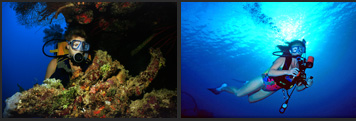| |
|
|
Underwater Strobes:
Part 4. TTL
TTL, or thru-the-lens metering, is the latest in a long line of
improvements to flash photography. In theory it's probably the
greatest boon to flash photography since the flashtube. In
practice, however, it often falls short of expectation. Or,
perhaps, it might be more accurate to state that it falls short of
many users' expectations. Here's why: TTL metering is often
fooled.
In theory, TTL automatically adjusts for any lighting situation,
adjusting the strobe's output for perfectly-exposed pictures,
regardless of the aperture chosen or prevailing light conditions.
In essence, light pours out of the strobe, reflects back from the
subject, and then a sensor stops the output when a "perfect" exposure is detected.
The problem with TTL metering is
that it's based on an "idealized" setting that is rarely
encountered in real life. Several situations will confuse the
sensor to give an incorrect exposure. Consider the two images
below. The first is perfect for TTL, the second is not.
 |
|
Idealized Background |
|
Confusing Background |
|
|
















